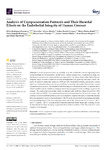Mostrar o rexistro simple do ítem
Analysis of Cryopreservation Protocols and Their Harmful Effects on the Endothelial Integrity of Human Corneas
| dc.contributor.author | Rodríguez-Fernández, Silvia | |
| dc.contributor.author | Álvarez-Portela, Marcelino | |
| dc.contributor.author | Rendal Vázquez, María Esther | |
| dc.contributor.author | Piñeiro-Ramil, María | |
| dc.contributor.author | Sanjurjo-Rodríguez, Clara | |
| dc.contributor.author | Castro Viñuelas, Rocío | |
| dc.contributor.author | Sánchez-Ibáñez, Jacinto | |
| dc.contributor.author | Fuentes Boquete, Isaac Manuel | |
| dc.contributor.author | Díaz-Prado, Silvia | |
| dc.date.accessioned | 2021-11-29T08:27:12Z | |
| dc.date.available | 2021-11-29T08:27:12Z | |
| dc.date.issued | 2021-11-22 | |
| dc.identifier.citation | Rodríguez-Fernández S, Álvarez-Portela M, Rendal-Vázquez E, Piñeiro-Ramil M, Sanjurjo-Rodríguez C, Castro-Viñuelas R, Sánchez-Ibáñez J, Fuentes-Boquete I, Díaz-Prado S. Analysis of cryopreservation protocols and their harmful effects on the endothelial integrity of human corneas. Int J Mol Sci. 2021 Nov 22;22(22):12564. | es_ES |
| dc.identifier.issn | 1422-0067 | |
| dc.identifier.uri | http://hdl.handle.net/2183/28978 | |
| dc.description.abstract | [Abstract] Corneal cryopreservation can partially solve the worldwide concern regarding donor cornea shortage for keratoplasties. In this study, human corneas were cryopreserved using two standard cryopreservation protocols that are employed in the Tissue Bank of the Teresa Herrera Hospital (Spain) to store corneas for tectonic keratoplasties (TK protocol) and aortic valves (AV protocol), and two vitrification protocols, VS55 and DP6. Endothelial viability and general corneal state were evaluated to determine the protocol that provides the best results. The potential corneal cryopreservation protocol was studied in detail taking into consideration some cryopreservation-related variables and the endothelial integrity and stroma arrangement of the resulting cryopreserved corneas. TK corneas showed mostly viable endothelial cells, while the others showed few (AV) or none (DP6 and VS55). The corneal structure was well maintained in TK and AV corneas. TK corneas showed endothelial acellular areas surrounded by injured cells and a normal-like stromal fiber arrangement. Cryoprotectant solutions of the TK protocol presented an increasing osmolality and a physiological pH value. Cooling temperature rate of TK protocol was of 1 °C/min to −40 °C and 3 °C/min to −120 °C, and almost all of dimethyl sulfoxide left the tissue after washing. Future studies should be done changing cryopreservation-related variables of the TK protocol to store corneas of optical grade. | es_ES |
| dc.description.sponsorship | This research was funded by Xunta de Galicia (grant no. ED431B 2020/55), by Xunta de Galicia and the European Union (European Regional Development Fund; grant nos. ED481A-2019/206 and ED481A-2017/280), and by INDITEX and the University of A Coruña (grant no. 2019) | es_ES |
| dc.description.sponsorship | Xunta de Galicia; ED431B 2020/55 | es_ES |
| dc.description.sponsorship | Xunta de Galicia; ED481A-2019/206 | es_ES |
| dc.description.sponsorship | Xunta de Galicia; ED481A-2017/280 | |
| dc.language.iso | eng | es_ES |
| dc.publisher | MDPI | es_ES |
| dc.relation.uri | https://doi.org/10.3390/ijms222212564 | es_ES |
| dc.rights | Creative Commons Attribution 4.0 International Licence (CC-BY 4.0) | es_ES |
| dc.rights.uri | http://creativecommons.org/licenses/by/4.0/ | * |
| dc.subject | Corneal cryopreservation | es_ES |
| dc.subject | Cryoprotective agent | es_ES |
| dc.subject | Corneal endothelium | es_ES |
| dc.subject | Corneal storage | es_ES |
| dc.subject | Corneal transplantation | es_ES |
| dc.subject | DMSO | es_ES |
| dc.title | Analysis of Cryopreservation Protocols and Their Harmful Effects on the Endothelial Integrity of Human Corneas | es_ES |
| dc.type | info:eu-repo/semantics/article | es_ES |
| dc.rights.access | info:eu-repo/semantics/openAccess | es_ES |
| UDC.journalTitle | International Journal of Molecular Sciences | es_ES |
| UDC.volume | 22 | es_ES |
| UDC.startPage | 12564 | es_ES |
| dc.identifier.doi | 10.3390/ijms222212564 |
Ficheiros no ítem
Este ítem aparece na(s) seguinte(s) colección(s)
-
GI-TCMR - Artigos [129]
-
INIBIC-TCMR - Artigos [102]






